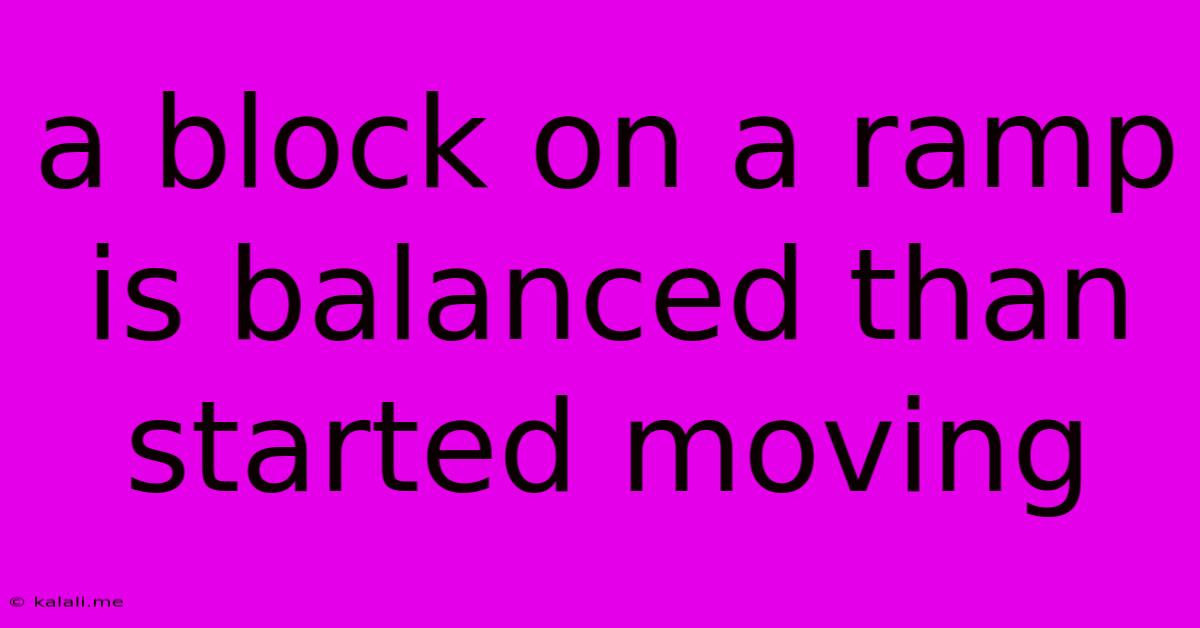A Block On A Ramp Is Balanced Than Started Moving
Kalali
May 31, 2025 · 3 min read

Table of Contents
A Block on a Ramp: From Static Equilibrium to Motion
This article explores the physics behind a block resting on an inclined ramp, transitioning from a state of static equilibrium to dynamic motion. We'll delve into the forces at play, the conditions that trigger movement, and the factors influencing the block's acceleration down the ramp. Understanding these concepts is crucial in various fields, from engineering and robotics to everyday scenarios involving inclined planes.
Understanding Static Equilibrium
Before the block begins moving, it exists in a state of static equilibrium. This means the net force acting on the block is zero. Several forces are at work here:
-
Gravity (Weight): This force acts vertically downwards, pulling the block towards the earth's center. Its magnitude is given by
W = mg, where 'm' is the mass of the block and 'g' is the acceleration due to gravity. -
Normal Force: This force acts perpendicular to the ramp's surface, preventing the block from falling through the ramp. It's a reaction force to the component of the weight that is perpendicular to the surface.
-
Friction (Static Friction): This force opposes the tendency of the block to slide down the ramp. It acts parallel to the ramp's surface and is directed upwards. Static friction has a maximum value, beyond which the block will begin to move.
The Transition to Motion: Overcoming Static Friction
The block remains stationary as long as the component of gravity parallel to the ramp (which tries to pull it downwards) is balanced by static friction. However, this balance is delicate. Increasing the angle of the ramp increases the parallel component of gravity. Eventually, this parallel component overcomes the maximum static frictional force, causing the block to begin sliding.
Factors Influencing the Transition:
Several factors determine when this transition occurs:
-
Angle of Inclination: A steeper ramp (larger angle) leads to a larger component of gravity parallel to the surface, making it easier for the block to overcome static friction.
-
Mass of the Block: A heavier block (larger mass) experiences a larger gravitational force, but the frictional force also increases proportionally (since it depends on the normal force, which in turn is affected by the weight). Therefore, mass itself doesn't directly affect the angle at which the block starts to move.
-
Coefficient of Static Friction: This dimensionless value (μs) represents the "roughness" between the block and the ramp. A higher coefficient means a stronger static frictional force, requiring a steeper angle for the block to slide. Different materials have different coefficients of static friction.
-
Surface Conditions: Imperfections and irregularities on the surfaces of the block and the ramp affect the actual frictional force, potentially making the prediction of the transition point less precise.
Motion Down the Ramp: Kinetic Friction
Once the block starts moving, static friction is replaced by kinetic friction (also called sliding friction). Kinetic friction is typically smaller than static friction. This means the block accelerates down the ramp, although the acceleration is usually less than if there were no friction.
Calculating Acceleration:
The net force acting on the block after it starts moving is the difference between the component of gravity parallel to the ramp and kinetic friction. This net force, along with the mass of the block, determines the acceleration using Newton's second law: Fnet = ma.
Conclusion:
Understanding the transition of a block from static equilibrium to motion on an inclined ramp involves a careful consideration of gravitational forces, normal forces, and the crucial role of friction—both static and kinetic. The angle of inclination, the coefficient of friction, and surface conditions are key factors influencing this transition and the subsequent motion of the block down the ramp. This seemingly simple scenario highlights fundamental principles of classical mechanics, illustrating the interplay of forces in a dynamic system.
Latest Posts
Latest Posts
-
Cant Purchase Smoke On The Water No Buy Option
Jun 02, 2025
-
Did God Tell Eve Not To Eat The Apple
Jun 02, 2025
-
Two Lights One Switch Wiring Diagram
Jun 02, 2025
-
Cat All Files In A Directory
Jun 02, 2025
-
2 To 1 Mux Truth Table
Jun 02, 2025
Related Post
Thank you for visiting our website which covers about A Block On A Ramp Is Balanced Than Started Moving . We hope the information provided has been useful to you. Feel free to contact us if you have any questions or need further assistance. See you next time and don't miss to bookmark.